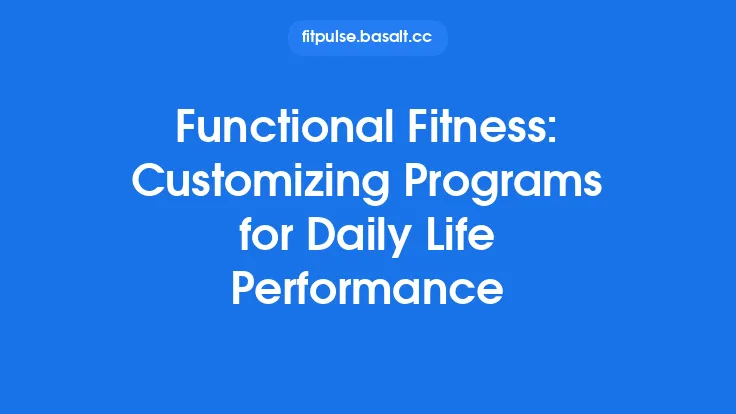Advanced Bodyweight Mastery: Periodized Programs for Elite Performance
The pursuit of elite‑level calisthenics demands more than a collection of impressive tricks; it requires a meticulously structured training architecture that balances maximal strength, refined skill, explosive power, and optimal recovery. While many athletes excel at isolated movements, the true differentiator lies in the ability to sustain progressive overload across multiple physiological systems over months and years. This article dissects the principles, methodologies, and practical tools needed to construct periodized, level‑based programs that push the boundaries of bodyweight performance. The focus is on evergreen concepts—principles that remain relevant regardless of equipment trends or competition formats—so that the guidance can serve athletes, coaches, and sport scientists alike.
Foundations of Advanced Periodization for Bodyweight Athletes
Periodization is the systematic planning of training variables (intensity, volume, frequency, and exercise selection) to elicit specific adaptations while minimizing fatigue and injury risk. In the context of bodyweight training, the variables take on unique forms:
| Variable | Bodyweight Equivalent | Typical Range (Elite) |
|---|---|---|
| Intensity | Lever‑based load (e.g., weighted vest %, band tension) | 70‑95 % of 1RM equivalents (weighted pull‑ups, weighted dips) |
| Volume | Sets × reps × exercise complexity | 8‑20 sets per session, 3‑12 reps per set (skill‑heavy) |
| Frequency | Sessions per week per movement pattern | 3‑5 × week for primary pulls, pushes, core |
| Complexity | Skill tier (basic, intermediate, advanced) | Progressive inclusion of planche, front‑lever, one‑arm variations |
The elite athlete’s program must simultaneously develop maximal strength (e.g., weighted pull‑ups > 30 kg), high‑velocity power (explosive muscle‑ups), and refined motor control (static holds > 30 s). Achieving this trifecta requires a macro‑level roadmap that cycles through distinct emphasis phases while preserving a baseline of skill maintenance.
Designing Macrocycles for Elite Skill Acquisition
A macrocycle typically spans 12‑24 weeks and serves as the overarching narrative of a training year. For elite calisthenics, macrocycles are often anchored around competition dates, testing windows, or specific skill milestones (e.g., full‑planche mastery). The macrocycle can be divided into three primary blocks:
- Accumulation Block (4‑6 weeks) – Emphasizes hypertrophy and foundational strength. Loads are moderate (70‑80 % 1RM), volume is high, and skill work is performed at sub‑maximal difficulty to reinforce movement patterns.
- Intensification Block (4‑6 weeks) – Shifts focus to maximal strength and high‑intensity skill execution. Loads increase (80‑90 % 1RM), volume tapers, and complex skills are practiced with added resistance (weighted vests, bands).
- Realization/Peaking Block (2‑4 weeks) – Prioritizes power, speed, and technical precision. Loads are near‑maximal (90‑95 % 1RM) for strength lifts, while skill sessions incorporate low‑volume, high‑quality attempts at competition‑level difficulty.
A deload week is strategically placed after each block to allow systemic recovery and neural reset. The macrocycle’s flexibility permits “double‑peak” structures for athletes targeting multiple competitions within a season.
Mesocycle Structuring: Strength, Power, and Skill Emphasis
Within each macro block, mesocycles (3‑4 weeks) dictate the day‑to‑day training emphasis. An elite program typically rotates through three mesocycle archetypes:
| Mesocycle Type | Primary Goal | Representative Sets/Reps | Key Exercise Modifications |
|---|---|---|---|
| Strength‑Dominant | Maximal force production | 4‑6 × 3‑5 (weighted pull‑ups, weighted dips) | Linear progression, occasional overload bands |
| Power‑Dominant | Rate of force development | 5‑8 × 2‑3 (explosive muscle‑ups, plyometric push‑ups) | Contrast loading (e.g., 3 × 5 kg vest → 3 × bodyweight) |
| Skill‑Dominant | Motor control & static strength | 3‑5 × max hold/transition (planche leans, front‑lever negatives) | Incremental difficulty via lever angle, band assistance reduction |
The mesocycle order can follow a linear progression (strength → power → skill) or an undulating sequence (skill‑heavy week, power‑heavy week, strength‑heavy week) depending on the athlete’s response to training stress. Elite athletes often employ a hybrid approach: a linear backbone with micro‑undulations to address specific weaknesses.
Microcycle Manipulation: Undulating vs. Block Approaches
A microcycle (7‑10 days) is the smallest planning unit and determines the day‑to‑day stimulus. Two prevalent models are:
- Undulating (Daily‑Undulating Periodization, DUP) – Daily variation in intensity and volume. Example:
- Monday: Heavy weighted pull‑ups (5 × 3) + planche leans (3 × 10 s)
- Wednesday: Explosive muscle‑ups (4 × 2) + front‑lever negatives (4 × 5 s)
- Friday: Moderate weighted dips (4 × 6) + static handstand holds (5 × 15 s)
DUP maintains a high neural stimulus, ideal for athletes with superior recovery capacity.
- Block (Conjugate‑Style) Periodization – Concentrates a single quality for 2‑3 days, then rotates. Example:
- Days 1‑2: Max strength (heavy weighted movements)
- Days 3‑4: Dynamic effort (speed‑focused bodyweight complexes)
- Day 5: Skill refinement (low‑volume, high‑precision holds)
The block model reduces intra‑week interference, allowing deeper adaptation of each quality.
Elite programs often blend both: a block structure for the week, with undulating variables within each block day.
Integrating Complex Skill Sets: Planche, Front Lever, and One‑Arm Variations
Advanced calisthenics is defined by a handful of “signature” skills that demand both absolute strength and refined neuromuscular coordination. Periodizing these skills requires:
- Progressive Lever Manipulation: Adjust the center‑of‑mass distance to modulate difficulty. For the planche, start with tuck‑planche leans, progress to advanced tuck, then straddle. For the front lever, move from tucked to advanced tucked, then to straddle and full.
- Weighted Skill Overload: Once a skill can be held for ≥ 15 seconds at bodyweight, introduce a 5‑10 % weighted vest to stimulate further strength gains. The overload should be cycled (2 weeks on, 1 week off) to avoid over‑stress on joints.
- Isometric‑Dynamic Hybrids: Pair static holds with dynamic transitions (e.g., planche push‑up to handstand). This hybrid approach improves both static strength and movement control.
- Specificity Windows: Allocate 2‑3 sessions per week for each high‑level skill, ensuring at least 48 hours of recovery between intense attempts. Use “skill‑maintenance” sessions (low‑volume, sub‑max) on off‑days to reinforce motor patterns without excessive fatigue.
Advanced Loading Techniques: Eccentric Overload, Isometrics, and Variable Resistance
To push beyond plateaus, elite athletes incorporate non‑traditional loading methods:
- Eccentric Overload – Perform the lowering phase with 120‑150 % of the concentric load (e.g., assisted one‑arm pull‑up with a band providing extra resistance on the descent). Eccentric emphasis enhances muscle fiber recruitment and connective tissue strength.
- Isometric Holds at Variable Joint Angles – Holding a dip at 90°, 120°, and 150° angles for 5‑10 seconds each builds joint‑specific strength, crucial for deep‑range planche and front‑lever positions.
- Variable Resistance Bands – Combine bands with weighted vests to create a “reverse‑band” curve: lighter at the bottom, heavier at the top of a pull‑up, mimicking the natural strength curve and improving lock‑out power.
- Partial‑Range Repetitions – Execute “partial” muscle‑ups focusing on the transition phase (from chest to bar) to overload the most demanding segment of the movement.
These techniques are cycled in 2‑week blocks within the mesocycle to prevent adaptation stagnation.
Optimizing Metabolic Conditioning for Calisthenics Performance
While strength and skill dominate elite programming, metabolic conditioning ensures the athlete can sustain high‑intensity efforts during long routines or competitions. Key considerations:
- High‑Intensity Interval Calisthenics (HIIC): 30 seconds of maximal effort (e.g., burpee‑to‑muscle‑up) followed by 30 seconds rest, repeated for 8‑12 rounds. This trains phosphocreatine recovery and lactate tolerance.
- Skill‑Integrated Conditioning: Combine conditioning with skill work (e.g., 5 × 10 seconds of handstand push‑ups interspersed with 30 seconds of static handstand). This maintains technical fidelity under fatigue.
- Aerobic Base Maintenance: 2‑3 low‑intensity sessions per week (e.g., 30‑45 minutes of steady‑state rowing or cycling) preserve cardiovascular health without compromising strength adaptations.
- Periodized Conditioning Load: Align conditioning volume with the macrocycle—higher during accumulation, reduced during intensification and peaking to avoid interference with maximal strength and skill execution.
Recovery and Regeneration Strategies for High‑Intensity Bodyweight Training
Elite athletes operate near the limits of physiological capacity; thus, recovery is as critical as the training stimulus. An evidence‑based recovery protocol includes:
| Modality | Frequency | Practical Implementation |
|---|---|---|
| Sleep Hygiene | 7‑9 hours/night, consistent schedule | Dark room, 30 min wind‑down, avoid screens |
| Active Recovery | 1‑2 × week | Light mobility circuits, band‑assisted range‑of‑motion drills |
| Contrast Showers | Post‑session (optional) | 1 min hot → 30 s cold, repeat 3‑4× |
| Myofascial Release | Daily (5‑10 min) | Foam roll thoracic spine, lats, hip flexors |
| Periodized Deloads | Every 4‑6 weeks (macro block transition) | Reduce volume by 40‑50 %, maintain intensity for neural maintenance |
| Nutrient Timing | Within 30 min post‑workout | 0.4‑0.5 g/kg protein + fast‑acting carbs (e.g., fruit + whey) |
Monitoring tools such as heart‑rate variability (HRV) and subjective wellness questionnaires help fine‑tune recovery interventions on a day‑to‑day basis.
Monitoring, Testing, and Data‑Driven Adjustments
Objective data guides the fine‑tuning of elite programs. Core metrics include:
- Strength Benchmarks: 1RM weighted pull‑up, weighted dip, weighted pistol squat. Test every 4‑6 weeks.
- Power Assessments: Explosive muscle‑up count in 30 seconds, vertical jump height (force plate or jump mat).
- Skill Proficiency: Maximal hold time for planche, front lever, and one‑arm push‑up; number of clean repetitions at competition difficulty.
- Physiological Load: Session RPE, total training volume (sets × reps × load), and weekly training stress score (TSS) derived from wearable data.
- Recovery Indices: HRV, resting heart rate, sleep quality scores.
Data should be plotted on a training‑performance matrix to visualize trends. When a plateau or regression appears, adjust one variable at a time (e.g., reduce volume by 10 % or swap a skill‑dominant day for a power‑dominant day) and re‑evaluate after 2‑3 weeks.
Nutrition Periodization to Support Elite Bodyweight Demands
Just as training is periodized, nutrition must align with the training phase:
| Phase | Caloric Goal | Macronutrient Focus | Sample Meal Timing |
|---|---|---|---|
| Accumulation | +10‑15 % above maintenance | Higher carbs (55‑60 %) for hypertrophy, protein 1.8‑2.2 g/kg | Carb‑rich meals around strength sessions |
| Intensification | Maintenance or slight surplus | Moderate carbs (45‑50 %), protein 2.0‑2.4 g/kg, increased omega‑3s | Protein‑dense meals pre‑ and post‑strength work |
| Realization/Peaking | Slight deficit (−5 %) if weight class required | Lower carbs (40‑45 %), high protein (2.2‑2.6 g/kg), electrolytes | Fast‑acting carbs 30 min pre‑competition, protein within 30 min post‑session |
| Deload/Recovery | Maintenance | Balanced macros, emphasis on micronutrients (vitamin C, magnesium) | Frequent small meals to aid tissue repair |
Supplementation (creatine monohydrate, beta‑alanine, branched‑chain amino acids) can be cycled to coincide with high‑intensity blocks, while anti‑inflammatory agents (turmeric, omega‑3) are emphasized during deload weeks.
Psychological Conditioning and Competition Peaking
Elite performance is inseparable from mental resilience. Incorporate:
- Visualization Sessions: 5‑10 minutes daily, mentally rehearse complex skill sequences under competition pressure.
- Goal‑Setting Framework: Set macro (seasonal), meso (block), and micro (weekly) objectives using the SMART criteria.
- Stress‑Inoculation Training: Simulate competition conditions (e.g., timed skill circuits, audience noise) during the final 2 weeks of the peaking block.
- Tapering Protocol: Reduce training volume by 40‑60 % while maintaining intensity for 5‑7 days before competition, allowing super‑compensation of strength and skill.
A structured mental routine enhances confidence and reduces performance anxiety, translating into cleaner execution of high‑risk skills.
Sample Elite 12‑Week Periodized Program Overview
Below is a condensed snapshot of a 12‑week macrocycle designed for an athlete targeting a full‑planche, front‑lever, and one‑arm pull‑up competition. The program assumes a baseline of 30 kg weighted pull‑up 5 × 3 and a 20‑second advanced tuck‑planche hold.
| Week | Block | Focus | Weekly Layout (example) |
|---|---|---|---|
| 1‑2 | Accumulation | Hypertrophy & Base Strength | Mon: Weighted Pull‑ups 5 × 5 (80 % 1RM) + Tuck‑Planche Leans 4 × 10 s<br>Tue: Plyometric Push‑ups 4 × 6 + Front‑Lever Negatives 4 × 5 s<br>Thu: Weighted Dips 5 × 6 + One‑Arm Assisted Pull‑up 4 × 4<br>Fri: Skill Circuit (Planche → Front Lever → One‑Arm) low volume, high quality |
| 3‑4 | Accumulation | Eccentric Overload | Mon: Eccentric Weighted Pull‑ups (3 s descent) 4 × 4 + Tuck‑Planche Holds 5 × 12 s<br>Tue: Band‑Assisted Front‑Lever Pulls 4 × 6 + Plyo Muscle‑ups 3 × 3<br>Thu: Weighted Dips 4 × 5 + One‑Arm Negative Pull‑ups 4 × 3 s<br>Fri: Active Recovery (mobility, light band work) |
| 5‑6 | Intensification | Max Strength & Heavy Skill | Mon: Weighted Pull‑ups 5 × 3 (90 % 1RM) + Advanced Tuck‑Planche 4 × 8 s<br>Tue: Weighted Front‑Lever Holds 4 × 6 s + Explosive Muscle‑ups 4 × 2<br>Thu: Weighted Dips 5 × 4 (95 % 1RM) + One‑Arm Pull‑up 4 × 2<br>Fri: Low‑Volume Skill Refinement (single‑rep attempts) |
| 7‑8 | Intensification | Power & Speed | Mon: Contrast Pull‑ups (3 × 5 kg vest → 3 × bodyweight) + Planche Push‑up Explosives 4 × 3<br>Tue: Front‑Lever Dynamic Pulls 5 × 3 + Plyo Push‑ups 5 × 5<br>Thu: One‑Arm Pull‑up Negatives 4 × 4 s + Weighted Dips 4 × 3 (80 % 1RM) fast tempo<br>Fri: HIIC Calisthenics 8 × 30 s work/30 s rest |
| 9‑10 | Realization | Competition‑Specific Peaking | Mon: Full‑Planche Attempts (max weight) 3 × 2 s + Front‑Lever Holds 3 × 4 s<br>Tue: One‑Arm Pull‑up Max Reps (bodyweight) 4 × max<br>Thu: Light Weighted Pull‑ups 3 × 3 (70 % 1RM) + Skill Flow (Planche → Front Lever) <br>Fri: Taper Conditioning – 4 × 30 s burpee‑to‑muscle‑up, long rest |
| 11‑12 | Taper & Recovery | Deload & Mental Prep | Mon: Bodyweight Pull‑ups 3 × 5 + Planche Leans 3 × 8 s<br>Tue: Front‑Lever Tuck Holds 3 × 6 s + Light Mobility<br>Wed: Rest + Visualization<br>Thu: One‑Arm Pull‑up Assisted 3 × 3 + Light Conditioning (jump rope)<br>Fri: Competition Simulation (full routine) low intensity |
Key Points:
- Volume is systematically reduced while intensity is maintained or slightly increased during the intensification and realization phases.
- Skill sessions are always present, but the load (sets/reps) is modulated to prevent excessive neuromuscular fatigue.
- Deload weeks (Weeks 11‑12) prioritize recovery, mental rehearsal, and fine‑tuning of technique.
Closing Thoughts
Elite bodyweight mastery is not a product of isolated “miracle” exercises; it is the outcome of a rigorously periodized system that harmonizes strength, power, skill, conditioning, recovery, nutrition, and psychology. By embracing a level‑based framework—where each training phase builds upon a verified foundation—and by applying advanced loading, data‑driven monitoring, and strategic peaking, athletes can consistently push the envelope of what the human body can achieve without external equipment. The principles outlined here are timeless, adaptable to any skill set, and designed to serve as a blueprint for sustained, high‑level performance in the ever‑evolving world of calisthenics.





